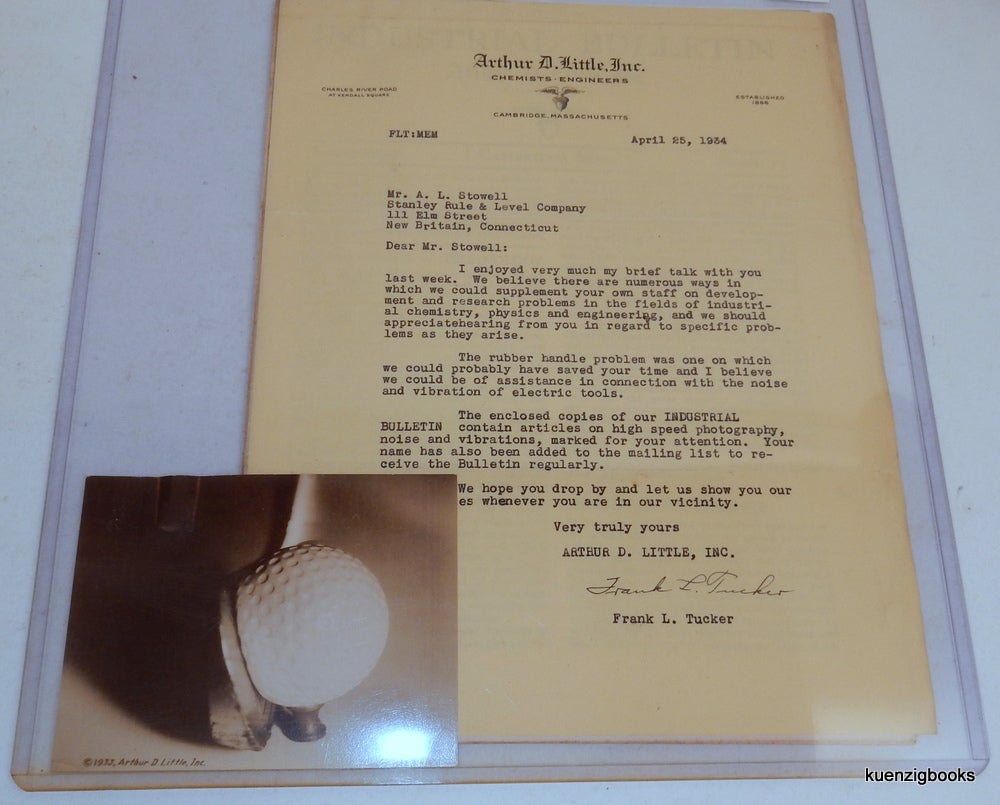
Group of Industrial Bulletins from Arthur D. Little, Inc. related to High-Speed Photography as well as a photograph of "Golf Ball at Instant of Impact" by Harold Edgerton and K. J. Germeshausen from MIT
Cambridge, Massachusetts: Arthur D. Little, Inc. 1933. First Edition. A set of 4 Industrial Bulletins from Arthur D. Little, Inc. (Jan, Mar, and Dec 1933 plus June 1934) along with a letter from Frank L. Tucker of Arthur D. Little, Inc. (Chemists, Engineers) and a small promotional photograph (c) 1933 Arthur D Little Inc. showing a golf ball at the instant of impact by a club. Printed on the rear of the card is a description of the process, and it's application to industrial research, noting H. E. Edgerton and K. J. Germeshausen at MIT were the technical innovators. The bulletins are 8 1/4 x 11 inches,3 of which are stamped "Marked Copy", noting 2 articles on Vibration and one on High Speed Photography. The photograph is 4 1/3 x 3 1/2 inches, and copyrighted by Arthur D. Little in the image. It has crazing to the surface finish, as well as creasing from a paper clip upper left. All are creased upper left where an old paper clip previously held them together, and other than the photograph were folded for mailing. Very Good. [24125]
With the increasing complexity and speed in manufacturing processes in the early part of the 20th century, industrial engineering had a problem. How on earth do you figure out what was happening when that $100,000 piece of equipment suddenly shrieked and flew apart? Post-mortems allowed limited analysis of failure modes, but wouldn't it be nice to figure out what was happening beforehand? While the high speed equipment was still in motion?
Enter Harold "Doc" Edgerton (whose name is today synonymous with strobe photography). Doc began his graduate work at MIT in 1926 and through 1931 experimented with strobes and photography in his studies of synchronous motors. Shortly after becoming a Professor, Doc Edgerton and several of his students (including K. J. Germeshausen) began to consult with industrial concerns, using the new strobe photography to freeze machines in action and help debug industrial processes, and in at least one case debunk patent infringment cases. It was an important new tool in the industrial engineer's arsenal.
Arthur D. Little, a local consulting firm, couldn't help but become aware of this new technology. They were after all in the business of offering analytical advice to those in industry and finance about notable trends, figures, and technologies and kept a close eye on those geniuses at MIT just down the street.
In their December 1933 bulletin, they highlight applications of the rapidly evolving high speed photography technology, and end by noting "A future of industrial usefulness is apparently in store for high-speed photography - applied to time as the microscope and telescope have been applied to space."
The grouping offered here was sent in response to a query by Mr. A. L. Stowell of Stanley Rule & Level Company noting: "We believe there are numerous ways in which we could supplement your own staff on development and research problems in the fields of industrial chemisty, physics and engineering, ... We hope you drop by and let us show you our laboratories whenever you are in our vicinity." The grouping from Arthur D. Little included a small photograph freezing a golf ball at the moment of impact which would have been astounding to most industrial engineers at the time.
This grouping demonstrates an early and important view into the partnership between industry (brokered by consulting firms like Arthur D. Little) and education (with top notch schools like MIT and Doc Edgerton). In addition it has to be one of the earliest uses of strobe photography in industrial consulting literature. Edgerton would go on to found EG&G (which photographed early atomic bomb work), work in radar, sonar, and many other innovative areas. Arthur D. Little, founded in 1886, is the world’s first management consultancy and remains in business today.
Price: $1,250.00

